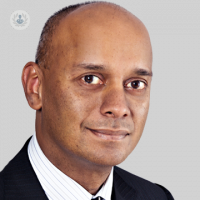What happens during a knee replacement procedure?
Written by:In one of our latest articles, Mr Michael Thilagarajah, a highly revered London-based consultant trauma and orthopaedic surgeon, details how a knee replacement procedure is typically performed, how long the surgery usually takes, and the potential associated complications.

What are the main reasons that lead to a knee replacement being required?
Knee replacements, in the majority of patients, are required as a result of the ageing of the knee, and an eventual wearing down of the knee, which is essentially arthritis. There are smaller groups of patients who will have problems with their knees after significant trauma to the knee when they were much younger. Some patients also have problems that run through the family relating to knee joints, which prematurely wears out the knee.
How is a knee replacement generally performed? What happens during the procedure?
A knee replacement operation is carried out under either a general anaesthetic or a spinal anaesthetic (where the lower half is made numb). The approach to the knee is generally down the front of the knee.
The scar is directly over the kneecap. It can be quite painful post-operatively because the patient is encouraged to bend and straighten the knee. There is no chance of the wound opening up, which is sometimes a concern for patients. It is quite uncomfortable to do those exercises, but it is paramount to do them to get the best outcome from the knee replacement.
Once the knee is exposed, we shape the ends of the bones to accept the new knee replacement, which is essentially a highly polished metal surface, which is either cemented or uncemented onto the bone of the femur (the thigh bone). This then meets up with the other half of the joint (the tibia), and that generally has a metal plate on top, and between the two of them, there is a plastic liner which forms the articulating surface, which removes the pain of the arthritis.
How long does it take?
The operation can take between an hour and an hour and a half. We encourage all patients to get their knee moving as quickly as possible after the operation. Physiotherapy will be recommended to patients hereafter.
How safe and effective is it?
The operation itself is tried and tested, and the success rate is very high. There is, however, a complication profile that affects a very small number of patients, quoted at roughly between two and five per cent, but it is rarer to suffer a significant complication. General complications can include:
- bleeding
- infection
- blood clots in the leg
- stiffness
- numbness
- weakness
- swelling
- damage to nerves, tendons, and blood vessels around the joint
Mr Michael Thilagarajah is a highly accomplished and distinguished consultant trauma and orthopaedic surgeon who specialises in performing knee replacement surgery. Consult with him today via his Top Doctors profile if you are considering undergoing a knee replacement in the near future.


